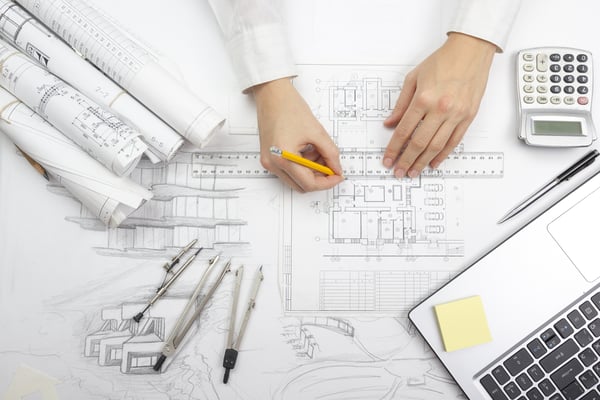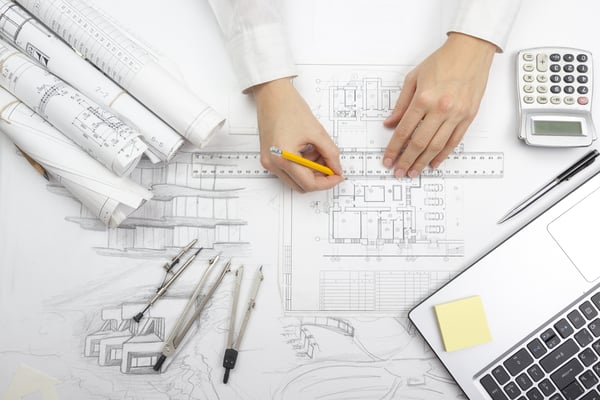Architects are responsible for project design and planning, and are also responsible for the visual appearance of buildings and structures. The term “architect” only refers to individuals registered with a local government body. To become licensed, architects must meet specific professional education requirements and pass an exam. Architectural services can be obtained from unlicensed individuals, but they cannot call themselves architects and cannot sign construction documents.
Architects work side by side with other professionals, such as civil and HVAC engineers, to deliver qualified projects. Architects have diverse responsibilities during all stages of a project, from initial sketches and meetings to the opening of a building. Architects are appointed by the client and are tasked with gathering all the information and ideas necessary to create a functional space that meets the client's needs while also being code compliant.
Keep your project on track with professional construction management services.
Roles of architects in construction
Once an architect is contacted by a client, a meeting is called to discuss the needs and requirements of the project. Several meetings may occur until both parties are satisfied with the conceptual design. However, designing an entire building is a huge task for a single person; Architects work with civil and structural engineers to discuss technical issues and the structural integrity of a building.
Architects are not only involved in the building design phase. Your role is important at every stage of a project and this article summarizes your responsibilities. Architects can also help improve energy efficiency by designing buildings that maximize natural lighting and ventilation while reducing heating and cooling needs.
Project Discussion
An architect is hired by a client to create a detailed design of a concept or idea that the client wants to bring to life. Meetings and discussions with different team members and engineering professionals take place before project approval. Some topics that should be discussed during these meetings are client requirements, expected budget, site characteristics, safety and local planning regulations.
Documentation and Drawings

Architects are responsible for creating detailed drawings and testing the project's feasibility. Traditionally this was done manually, but modern BIM and CAD software significantly speeds up the process. During this phase, multiple revisions and redesigns occur to incorporate changes based on client needs, budget and regulations.
Final designs guide builders in delivering the desired structure, and this includes plans for all structural, mechanical and electrical systems. Other technical documents that must be prepared along with the plans are design instructions and technical specifications for contractors. After the final design comes the contract proposal, which allows the creation of cost estimates and the project schedule.
Cost Estimation
Cost estimation in the different phases of the project allows for better budget control. Architects visualize the entire structure of the building, bringing creative designs and ideas to the construction industry, but these also require an underlying structural design and MEP installations.
Architects and engineers must be careful not to underestimate the cost of materials and construction time, as this helps to provide effective cost estimates. The amount of detail presented by architects in their cost estimates depends on the extent of the work: they can be responsible for presenting a complete construction estimate or just a part such as landscaping.
Contracts
Architects can help in the contract negotiation phase, being able to suggest and choose contractors for various activities. Once all proposals have been received, the architect prepares analysis reports and compares the results with the client's expectations and budget.
Construction stage
After construction begins, the architect will conduct site visits and meetings, contract negotiations, and address and resolve any issues that may occur. Some of the documentation that occurs during the construction phases will require the architect's signature and approval.
Architect skills and duties
The following are some of the key skills that a professional architect must have:
- Client service and retention : It is important for architects to develop social skills and good manners as they are often the first construction professionals to work with a client. Because they work closely with clients during all phases of the project, architects must have excellent oral and written communication skills.
- Design : Architects must design, plan, and develop concepts to create construction plans and technical documents. They are based on customer requirements and ideas.
- Research : Architects must learn about the different building codes, safety regulations, construction innovations, and municipal laws that affect their projects. Because these regulations are constantly evolving, they must be up to date with new laws and requirements.
- Technological knowledge : Architects must be trained in software and modeling techniques, such as BIM. This will help them stay competitive in the construction industry, which is becoming increasingly technological.
Main differences between an architect and a civil engineer
As discussed previously, architects and civil engineers work together during the planning, design, and construction phases of construction projects. The difference is reflected in the main objective of each professional.
- Architects will focus on the aesthetics, appearance, and functionality of a structure. It is important to note that architects also have technical knowledge of construction methods and structural design, but this aspect is mostly delegated to civil engineers.
- Civil engineers will focus on analyzing the structural integrity of the project. This included ensuring the structure will withstand the loads and forces it will endure during its service life.
By working together, architects and civil engineers can find innovative ways to meet the client's vision and requirements. A good working relationship between the two professions guarantees effective and successful work.

